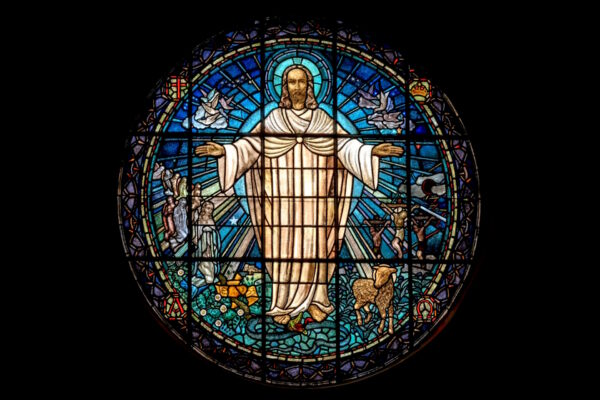In Peter’s sermon delivered on Pentecost, he proclaims: “Let all the house of Israel therefore know for certain that God has made him both Lord and Christ, this Jesus whom you crucified” (Acts 2:36). This verse is a short but profound summary of what the early church thought about Jesus of Nazareth; this was who they understood him to be. Peter was simply affirming what Jesus himself had already declared shortly before his death: “the stone that the builders rejected has become the cornerstone” (Luke 20:17; Acts 4:11-12).
Throughout the book of Acts, the Spirit-empowered church bears witness to Jesus as both the rejected-crucified Christ and the risen-exalted Lord. These titles, and the redemptive-historical events to which they refer, are helpful for organizing and thinking through the primary ways Jesus is portrayed in Acts.
The Rejected-Crucified Christ
Luke’s account of what Jesus continued to do and teach—the account we know of as the book of Acts (see Acts 1:1)—continues to develop many of the themes established in his Gospel. One of the central themes of his Gospel is Jesus’ rejection by his people and his consequent crucifixion according to the sovereign plan of God; he is the rejected-crucified Christ (Luke 9:22). In fact, the Gospel of Luke concludes with Jesus explaining the monumental truth that the entire Old Testament was written to show that it was necessary that the Messiah “should suffer these things and enter into his glory (Luke 24:26-27, 45-47)! This is foundational for Luke’s second volume.
In virtually every major speech in Acts, it is made known that Jesus was delivered up, rejected, crucified, and killed (Acts 2:23; 3:13-15, 18; 4:10-11; 5:30; 6:52; 10:39; 13:27-28; 26:23). On several occasions Luke mentions how Jesus was proclaimed to be the promised Messiah: “And every day, in the temple and from house to house, they did not cease teaching and preaching that the Christ is Jesus” (Acts 5:42; see also 9:22; 17:3; 18:5; 18:28). Jesus is also described as the promised suffering servant from the prophecy of Isaiah (Acts 3:13; 3:26; 4:27, 30; 8:32-35). Paul’s words to the Ephesian elders further illustrate the redemptive work of the rejected-crucified Christ by describing the church of God as being “obtained with his own blood” (Acts 20:28).
The Risen-Exalted Lord
Luke’s Gospel was written to reassure Theophilus that Christ’s suffering and death brought about the inauguration of the kingdom of God and the fulfillment of his covenant promises. For this reason, the book of Acts places a primary emphasis on the resurrection and ascension of Jesus; he is the risen-exalted Lord. Alan Thompson writes, “The book of Acts, therefore, is about the continuation of those saving promises, the kingdom of God, through the Lord Jesus. Jesus is still the mediator of that kingdom, the one who administers those saving promises and the one who carries out God’s saving plan.”[1]
Acts begins with references to Jesus’ resurrection and ascension (1:2-3, 9-11, 22). Along with being the rejected-crucified Christ, the description of Jesus as the risen-exalted Lord is likewise found in virtually every sermon and on every page of the book (Acts 1:6-8; 2:24-35; 3:15, 26; 4:2, 10-11, 33; 5:31; 6:56; 8:12; 10:40-42; 13:30-37; 17:3, 18, 30-31; 19:8; 23:6; 26:23; 28:23, 31). It is abundantly clear that “the resurrection is the climax of God’s saving purposes, and it is on the basis of the resurrection that the blessings of salvation may be offered.”[2] Furthermore, the major emphasis on the Holy Spirit throughout Acts is the direct result of Jesus’ ascension and exaltation: “Being therefore exalted at the right hand of God, and having received from the Father the promise of the Holy Spirit, he has poured out this that you yourselves are seeing and hearing” (Acts 2:33; emphasis mine).
Our God Reigns
The good news is that Jesus is both the rejected-crucified Christ and the risen-exalted Lord. In light of this, Darrell Bock provides a beautiful encouragement for the church’s witness and life today:
A dead savior is no savior at all. If Jesus were still in a grave, he could do no one any good. But raised and ascended to the side of the Father, Jesus can empower his children and enable his church. . . . For Luke, the death and resurrection of Jesus are important, but more important is his reign, both presently and in the age to come. For Luke, Jesus is not passively sitting in heaven awaiting his return. He lives, administers the benefits of salvation, and rules in anticipation of a more visible rule to come.[3]
There is no greater encouragement for the church today than to be reminded that “our God reigns” (Isa. 52:7)! Christ has dealt with our sin through his substitutionary death. He has been vindicated in his resurrection and triumph over death. He is currently ruling over and steadily defeating his enemies as Lord and will one day bring about the consummation of his glorious kingdom.
Until that day, may we boldly bear witness to this gospel in the power of the Spirit. May we confidently proclaim the good news of the kingdom of God and the gracious invitation of the Lord Jesus Christ to call upon his name and be saved (Acts 4:12; Rom. 10:9-13). And as citizens of that kingdom, may we walk in a manner worthy of our Lord, bearing fruit in every good work (Col. 1:10-12).




